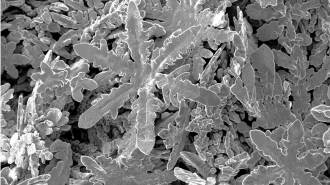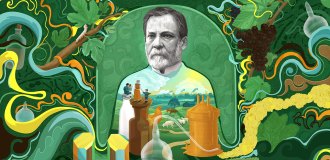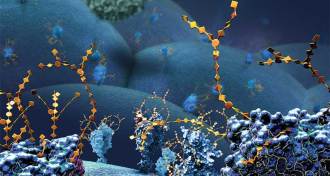Chemistry
Sign up for our newsletter
We summarize the week's scientific breakthroughs every Thursday.
-
 Planetary Science
Planetary ScienceThe last vital ingredient for life has been discovered on Enceladus
The underground ocean on Saturn’s icy moon may contain phosphorus in concentrations thousands of times greater than those found in Earth’s ocean.
By Nikk Ogasa -
 Chemistry
ChemistryHow to make tiny metal snowflakes
In a pool of molten gallium, researchers grew symmetrical, hexagonal zinc nanostructures that resemble natural snowflakes.
By Nikk Ogasa -
 Health & Medicine
Health & Medicine‘Forever chemicals’ may pose a bigger risk to our health than scientists thought
PFAS are linked to obesity, cancers and more. Growing evidence of the chemicals’ risks has prompted new guidance for safe drinking water and consumer testing.
-
 Health & Medicine
Health & MedicineLouis Pasteur’s devotion to truth transformed what we know about health and disease
Two centuries after his birth, Louis Pasteur's work on pasteurization, germ theory and vaccines is as relevant as ever.
-
 Earth
EarthCatastrophic solar storms may not explain shadows of radiation in trees
Tree rings record six known Miyake events — spikes in global radiation levels in the past. The sun, as long presumed, might not be the sole culprit.
By Nikk Ogasa -
 Chemistry
ChemistryMixing gold ions into whiskey can reveal its flavor
By changing the spirit’s color, the formation of gold nanoparticles can reveal how much flavor a whiskey has absorbed from its wood cask.
By Nikk Ogasa -
 Chemistry
ChemistryA way to snap molecules together like Lego wins 2022 chemistry Nobel
Click chemistry and bioorthogonal chemistry allow scientists to build complex molecules in the lab and in living cells.
By Meghan Rosen and Nikk Ogasa -
 Chemistry
ChemistryJosep Cornella breaks boundaries to make new and better catalysts
Josep Cornella reinvents chemical reactions essential for agriculture and the pharmaceutical industry.
By Anna Gibbs -
 Chemistry
ChemistryWhy once-gold ceilings in Spain’s Alhambra palace have purple stains
Moisture infiltrated flawed gilding at the iconic palace, leading to corrosion that deposited gold nanoparticles of the right size to appear purple.
By Carmen Drahl -
 Climate
ClimateHow to make recyclable plastics out of CO2 to slow climate change
Companies are turning atmospheric CO2 from smokestacks and landfills into plastics to shrink their carbon footprint.
-
 Climate
ClimateA carbon footprint life cycle assessment can cut down on greenwashing
As companies try to reduce their carbon footprint, many are doing life cycle assessments to quantify the full carbon cost of their products.
-
 Environment
EnvironmentCommon, cheap ingredients can break down some ‘forever chemicals’
Forever chemicals, or PFAS, are harmful compounds that are very difficult to degrade. But some are no match for lye and dimethyl sulfoxide.
By Jude Coleman